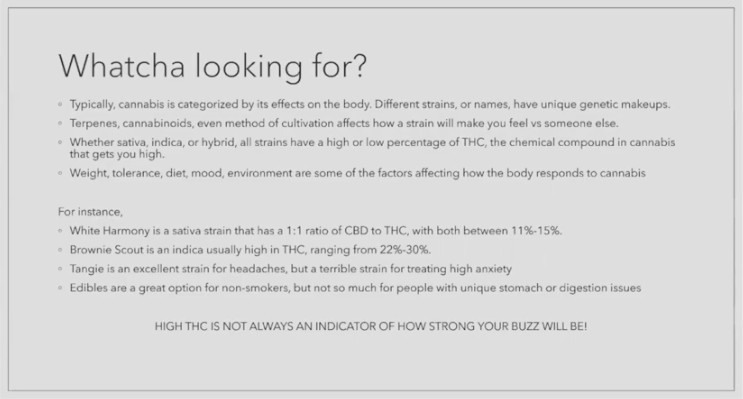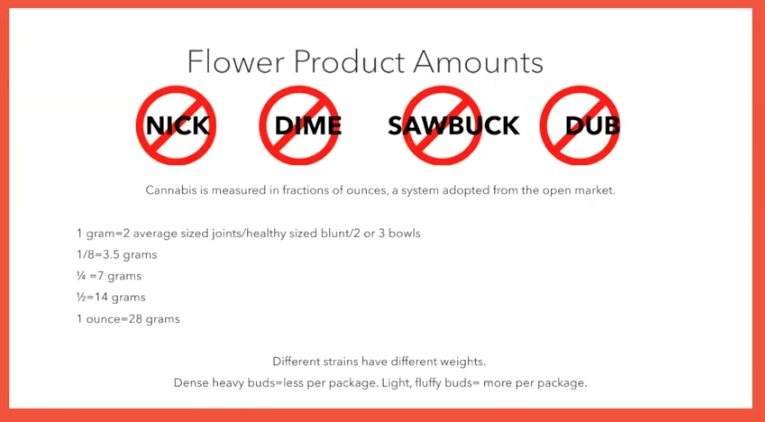How to be a Legal Cannabis Consumer in Illinois
Image from Purchasing Recreational Cannabis in Illinois presentation by Jondae Scott of Chicago NORML
At Chicago NORML’s 420 celebration in April, 2020, Jondae Scott explained how to be a smart cannabis consumer by describing how to purchase legal weed in Illinois. She is a supervisor at a Mission dispensary location and the lead instructor for Chicago NORML in its dispensary agent training program.
Scott says today’s legal marijuana is different from the weed found in the unregulated market in the past 50 years. “Rarely will you find a large amount of seeds or stems, unless it is shake,” which Scott describes as “the seeds, stems, leaves, [and] all trimmings from the plant.”
One of the biggest differences with legal weed is the high prices compared to purchases in the unregulated market or in places with a longtime cannabis market and culture such as Denver, Los Angeles, Oakland, and Michigan. “The average eighth [of an ounce} may cost from $30 to $45 on the market. When I was a street pharmacist, I recall my eights were like $25 to $30. Today you could easily see an eighth of an ounce sold anywhere from $50 to $75 plus tax.”
Image from Purchasing Recreational Cannabis in Illinois presentation by Jondae Scott of Chicago NORML
She pointed out that dispensaries have building costs, employee payrolls, security expenses, licensing costs and legal compliance fees and expenses. Scott said the state limits the number of cultivators and the size of their grow operations, creating unnecessary scarcity. Eventually, this will expand and we will see prices come down.
Many have seen the videos of people visiting marijuana emporiums in Colorado or California and being greeted by bearded dispensary workers in tie-died shirts who would open jars of bulk marijuana to smell and packing a bowl (a cannabis pipe) for the visitor to have a sample smoke. While rifts of psychedelic music or jam bands like the Grateful Dead played in the background, the customer would make a selection and the worker would scoop the cannabis out of the jar, weigh it on a scale, and present the bulk cannabis to the customer in a bag.
Image from Purchasing Recreational Cannabis in Illinois presentation by Jondae Scott of Chicago NORML
In Illinois, Scott explained, “You are not going to see that at all. Customers cannot have access to touching the actual unwrapped product in any Illinois dispensary. That really is for the safety and health of you. Nothing is weighed on site. Nothing is packaged on site [or] rolled in the corner. It is not so in your face the way it’s portrayed on TV or once again in other markets. When a product is delivered in large batches to a dispensary, it is already packaged and labeled. I beg of you to just keep that in mind when you visit a dispensary and please be patient with the employees. We know what you are expecting and wholeheartedly relate to the fact that you would love to see the product and touch different items.”
“Gone are the days of the little plastic baggies,” Scott declared. “I love those baggies. They are part of my heart, but you will not find cannabis sold this way. The first reason: those bags are not smell proof. They are also not childproof. Another thing, there are no weights, measurements, …no contents of cannabinoids on ingredients, [or] no expiration date.” In a dispensary, cannabis will be sold differently from the weed grown in a friend’s basement and processed in his kitchen, no matter which cannabis product it is. Because marijuana degrades when exposed to light, most packaging at legal dispensaries is of a dark color and the cannabis cannot be seen.
Image from Purchasing Recreational Cannabis in Illinois presentation by Jondae Scott of Chicago NORML
“The best way to make an educated purchase in a dispensary is to know what you are purchasing,” Scott advises. “Cannabis is a whole science course in itself.” It is important to “know a couple of key things. For instance, cannabinoids. These are the chemical compounds found in cannabis. You may know them as THC, CBD, CBG. CBN—but the two main ones are THC and CBD. Now there are over a hundred cannabinoids. These different combinations are unique in the way they deliver relief to the body.”
For the second consideration in selecting cannabis at a dispensary, Scott says, “We have to remember it is still a plant and plants secrete oils and those oils are called terpenes. Besides cannabis, fruits and flowers also have terpenes. These give plants their taste and smell that make them unique. As marijuana lovers know, it has a distinctive odor that can be recognized from a long distance. When consumers smell cannabis before a purchase, they are assessing how their body responds to the terpene profile to determine if the strain will benefit them. Many researchers have found that terpenes are as important to a cannabis experience as cannabinoids. This is why a cannabis strain with a certain terpene profile that is low in THC can deliver an experience similar to a strain with a high level of THC. A strain is a unique type of cannabis that has been given a name by the grower.”
Image from Purchasing Recreational Cannabis in Illinois presentation by Jondae Scott of Chicago NORML
Scott is clear to inform that “loud, exotic and gas are not strains. They are not types of cannabis. They technically don’t exist. They are all slang terms.” She said people regularly visit dispensaries asking for “loud” cannabis, but no strains are ever labeled with this and other slang terms.” However, strains are categorized by the way they affect the body. There are three main groups [or subspecies]. Sativas are uplifting, energizing and good for focus. Scott said it “gives you more of that head high, really cerebral, often psychoactive [experience] indicas can be thought of as strains where users like to hang out in the couch. They are relaxing and sedating.”
Scott says these strains deliver a “body high” that does not cause sleep but a definite downshifting chill in mood. The third kind of strain is a hybrid mixture of both subspecies. With growers and cultivators crossing award winning cannabis strains with each other, “currently, cannabis is mostly all hybrids,” Scott explained. “I would give or take at least 80 percent of all strains are technically hybrids. That’s because hybrids are needed to make new strains. Crossing two strains to make another one: that’s a hybrid.” Now, consumers will typically find an indica or sativa dominant strain with complex properties rather than a pure strain with limited benefits. “It gives the buyer more of a choice in how they want to feel after consumption.”
Scott advises consumers to plan their dispensary visit in advance. Some dispensaries allow only one visit a day. Those that have no limits, have many different strains in what seems to be an endless number of cannabis products that can be smoked, placed under the tongue, eaten, or rubbed on the skin.
Image from Purchasing Recreational Cannabis in Illinois presentation by Jondae Scott of Chicago NORML
“Ask yourself before entering a dispensary ‘What are you looking for?’ Trying to get high, have a good time? Great. Can’t get to sleep? Okay, let’s talk about it. Coming in [to a dispensary] saying ‘I just want to buy some good weed’ may lead [consumers] …into purchasing something [they] …really don’t want.”
— Jondae Scott
Both indicas and sativas can have high or low levels of THC. “If you have …a strain you really, really like [such as] Lavender Kush” Scott offers as an example. “Usually when you purchase it, it’s 22 percent THC. That’s a pretty average amount in Illinois. The next time you come back into the dispensary that Lavender Kush is 18 percent. Is it still Lavender Kush? Yes. Does it still have the terpene profile? Most likely. Is it still going to affect you in the way it affected you the last time you consumed it? Possibly, but maybe not. The reason being is that cannabis is a very delicate plant easily stressed.”
“The slightest change to the environment, the grow process, [and] the nutrients can affect how it tests out in the cannabinoid field. That’s right, when it is tested in a lab, whatever comes up can be different every single time. That’s okay. It is a plant.
— Jondae Scott
“The slightest change to the environment, the grow process, [and] the nutrients can affect how it tests out in the cannabinoid field. That’s right, when it is tested in a lab, whatever comes up can be different every single time. That’s okay. It is a plant. Just remember, when you find something that works for you, try to find out what about that strain makes it beneficial and not the strain itself. Why? The next time you come back to the dispensary, the strain may not be there anymore. I know you love that Lavender Kush, but it takes about two or three months to grow and cultivate and properly package that Lavender Kush. So instead of getting hooked on one strain, be open minded to the characteristics of that strain so that you can know what to look for just in case your dispensary does not have it next time. Learning what’s best for you can open the doors to a wide world of strains that are just catered to you.”
— Jondae Scott
Additionally, Scott said the body develops a tolerance to ingested items and the strain will likely become ineffective with regular and repeated use. To prevent this, the consumer will need to switch between a cluster of cannabis strains with similar properties. Scott explained cannabis companies round to the nearest gram or half gram and do not provide the precise amount of marijuana. For example, an eighth of an ounce is sold as 3.5 grams rather than 3.54 grams. A half ounce is seven grams instead of 7.14 grams and a whole ounce is sold as 28 grams rather than the actual 28.35 grams. As is said in Las Vegas, the house always wins. While the possession limit of flower is 30 grams, dispensaries likely will not sell this much to a visitor in a transaction so inventory can be maintained. Bring a buddy if you want to buy more than the dispensary limit.
Image from Purchasing Recreational Cannabis in Illinois presentation by Jondae Scott of Chicago NORML
Finally, dispensary visitors are encouraged to be patient. Even the most seasoned and experienced dispensary workers do not know the answer to every question. Resources and sometimes experts may need to be consulted to deliver a quality answer. Scott encourages folks to conduct a Google search before entering the dispensary and asking questions. Consumers should bring cash, as marijuana businesses have limited availability to banks. Dispensaries have automatic teller machines, which have sky high fees.
Consumers who bring cash from their own bank’s ATM or use an Internet bank or brokerage that refunds ATM fees will avoid the charges. Everyone must bring a valid state identification card or driver’s license. Dispensaries can only sell to those 21 and older and different limits apply to in state and out of state residents.
Scott ended her presentation by wishing everyone to “have fun and be safe” but not consume in public, which is illegal.
“Chicago police do not play,” Scott warned.
Image from Purchasing Recreational Cannabis in Illinois presentation by Jondae Scott of Chicago NORML
Watch the full presentation by Jondae Scott on the Chicago NORML YouTube channel









